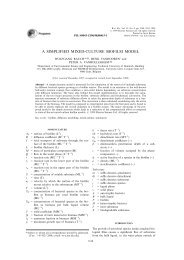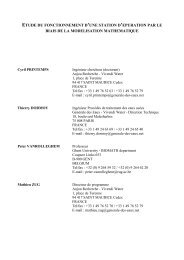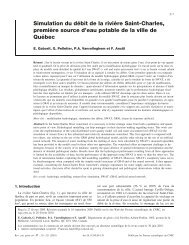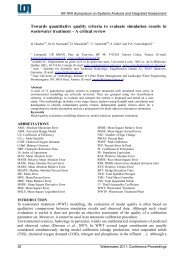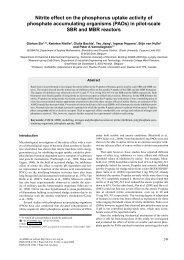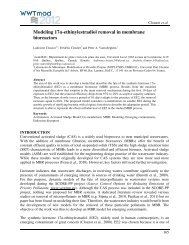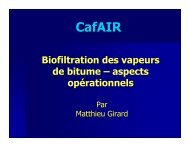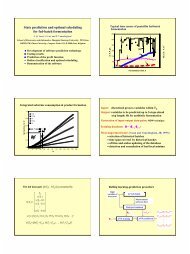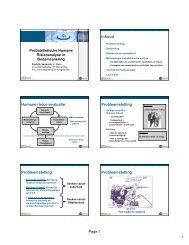Optimal control of the penicillin G fed-batch fermentation: An ...
Optimal control of the penicillin G fed-batch fermentation: An ...
Optimal control of the penicillin G fed-batch fermentation: An ...
You also want an ePaper? Increase the reach of your titles
YUMPU automatically turns print PDFs into web optimized ePapers that Google loves.
28 J. F. VAN IMPE ETAL.-11 -10 -9 4 -7 -6 4 4 -3 -2LolidB)Figure 6. <strong>Optimal</strong> production P(tf) as a function <strong>of</strong> BA constant strategy for 277-320 h with SO = 0 mol produces 1978.425 mol <strong>penicillin</strong>, so <strong>the</strong>gain using <strong>the</strong> optimal <strong>control</strong> is S= 130.7%.3.2.3. 0 < B Q pcrjt. As already mentioned, we can repeat <strong>the</strong>se calculations for every Bwithin <strong>the</strong> given boundaries. The result for <strong>the</strong> optimal production P(tf) as a function <strong>of</strong>parameter B is shown in Figure 6 as an illustration <strong>of</strong> Conjecture 1. From this plot we concludethat <strong>the</strong> sequence <strong>of</strong> optimal <strong>control</strong>s u*(B,t) is indeed convergent. Note also that forB < <strong>the</strong> cost has almost reached its limit value.4. PHYSICAL INTERPRETATION OF SINGULAR CONTROLIn Reference 4 <strong>the</strong> following <strong>the</strong>orem is proven for <strong>the</strong> performance index (8): if <strong>the</strong> specgcrates a, p, and a are functions <strong>of</strong> substrate concentration Cs only, with continuous derivativesup to second order, <strong>the</strong>n during singular <strong>control</strong> <strong>the</strong> substrate concentration remains constantif and only if <strong>the</strong> product decay constant kh equals zero. This constant value maximizes <strong>the</strong>ratio TI..We have already pointed out that <strong>the</strong> three specific rates u in (2), a in (3) and p in (4) arefunctions <strong>of</strong> substrate concentration Cs only. However, owing to <strong>the</strong> corner point in a, <strong>the</strong>sekinetics are not continuously differentiable for every value <strong>of</strong> C,. As a result, <strong>the</strong> above<strong>the</strong>orem cannot be used to characterize <strong>the</strong> singular <strong>control</strong> arc when using <strong>the</strong> originalHeijnen et al. model.On <strong>the</strong> o<strong>the</strong>r hand, <strong>the</strong> family <strong>of</strong> production kinetics (12) is sufficiently smooth to guarantee<strong>the</strong> applicability <strong>of</strong> this <strong>the</strong>orem. For <strong>the</strong> original model we prove <strong>the</strong> following <strong>the</strong>orem.Theorem IConsider <strong>the</strong> minimization <strong>of</strong> performance index (8) subject to <strong>the</strong> dynamic constraint (6).Suppose that <strong>the</strong> specific rates are modelled by equations (2)-(4) which are continuouspiecewise smooth functions <strong>of</strong> <strong>the</strong> substrate concentration. Then during singular <strong>control</strong> <strong>the</strong>substrate concentration remains constant if and only if <strong>the</strong> hydrolysis constant kh = 0 and is



